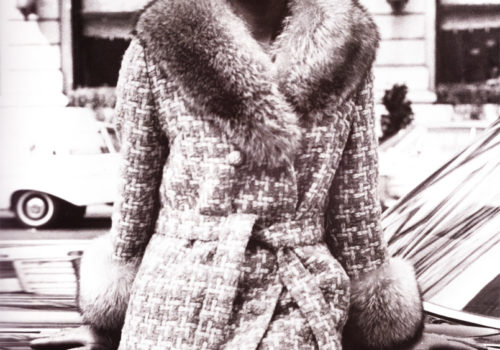The principle is simple. On the one side, there’s Michael McCollom, the African-American designer and photographer. One the other, there are all the people he asked to dig through their photo archives to find a portrait illustrating their idea of style. Not fashion—style. Then he compiled it all.
If boots are made for walking (Nancy Sinatra), these clothes seem made for living. The photographs date from the 1940s to the mid-’90s, and almost all of them are posed. Some were shot in studios, but most were taken by an amateur photographers, relatives and friends, in the street, at home, at bars, in parks and on prom night. They’re kind of selfies from another era.
All of the subjects chose or even designed their bombastic, stylish outfits, and they also chose to be photographed. “Here I am trying to be a model,” says Bethann Hardison, leaning against the mast of a wooden boat, wearing an ochre and vermillion turban. She looks off in the distance as if in a fashion shoot.
We visit several American cities during the star years of the sixties and seventies, and occasionally Paris. It’s part of the style. Each photograph comes with a caption from its subject. They’re short texts printed directly on the photos, like in Vogue. A photograph of Naomi Campbell and three other models, shot on the sly during a photo shoot in Annie Leibovitz, casts doubt rather it is a collection of amateur photographs or not. And it is. It’s a style notebook lit without spotlights.
The comments are full of tips and self-imposed rules of taste with a revealing subjectivity and a hint of self-deprecating. Michael McCollom sets the tone early in the book with a portrait of himself from 1986 in New York: “Okay, this one of those bad style decisions. I was still very cutting-edge; this photo was taken five years before Milli Vanilli appeared on the scene.” He has an afro, asymmetrical-on-the-sides, short-on-top-and-long-in-the-back haircut. His mustache has a hole that draws a vertical line in its middle. “Fashion” is written in capital letters on his white sweater.
Some people appear multiple times and at different stages of their lives – style is expressed starting in childhood, McCollom found. We see the same patterns, sometimes the same clothes, when they aren’t in the outright “twin mode” mentioned by “model, minister and mother” Sharon “Magic” Jordan in her comment of a 1971 photo of her and her sister. They’re dressed identically, from pants to earrings. Take humor, patterns and fabric, and you will get style!
Book
“The way we wore: Black style then”
Photography by Michael McCollum
Foreword by Geoffrey Holder
Published by Glitterati Incorporated
160 pages
ISBN: 978-0-9891704-4-4
30 dollars
http://glitteratiincorporated.com/products/the-way-we-wore-black-style-then-by-michael-mccollom
















